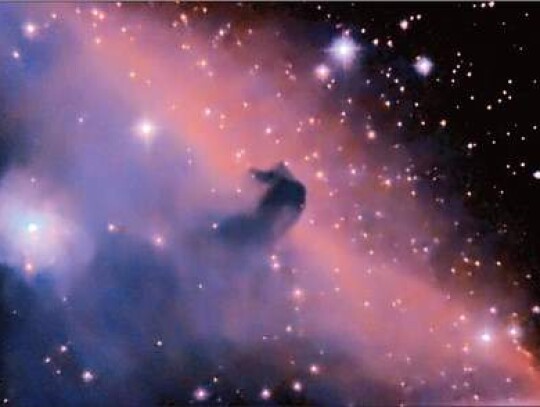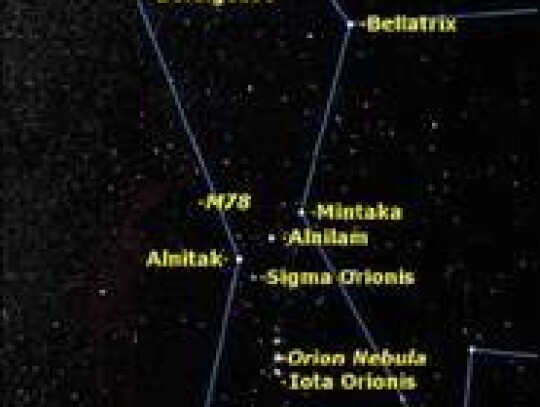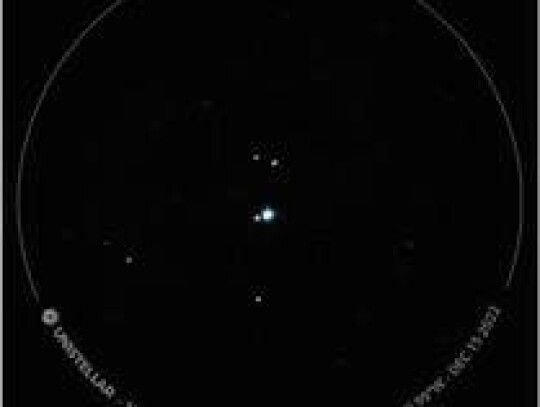Well, sadly we missed the Mars occultation by the Moon Dec. 7 and the Geminids meteor shower on Dec. 14. At least, from my house, it was cloudy both nights. I actually got to see a few moments of Mars and the Moon quite close together on the 7th, but it was fleeting. One of my neighbors texted me asking what that bright pimple looking thing was next to the moon. Such is life as an astronomer, being clouded out.
This month we’re going to talk about Orion which is rising conveniently in the east in January and February. By 8:45 p.m. in January, Orion will be conveniently placed in the southeastern sky. See the graphic of Orion and the stellar names. I want you to notice Sigma Orionis, which is a multiple star system below and to the right of Alnitak in Orion’s belt. This is actually responsible for illuminating the red portion of the Horsehead nebula just below and to the left of Alnitak. See my photo of the Horsehead taken Dec. 26, 2021, 83-minute image run.
Sigma Orionis is a star system made up of nine individual stars, five of which can be seen in my short exposure on Dec. 15, 2022. Can you imagine having the sun and eight other suns spinning around a common center of gravity in the night sky? Several of these stars are quite distant and wouldn’t look very bright in the sky.
The star we see in the middle photo is actually made up of three stars Aa and Ab are very close and B which is also pretty darn close. These three stars appear in the photo as slightly elongated, i.e. the star isn’t quite round. That is because we’re actually looking at the 3 of them.
I can’t image this system is stable enough to allow life on any planet that might be orbiting. Too much radiation from all these nearby stars and not enough of a possible stable orbit for any planet. Of course, I could be wrong, as Jeff Goldblum said in the original Jurassic Park movie, “Life finds a way”.
The most distant of the Sigma Orionis stars, the D star, is 4,680 AU distant from the 3 primary stars. Our most distant “planet” is Pluto which is only 39.5 AU distant. An AU (astronomical unit) is the distance from the Earth to the Sun. Pluto is 39.5 times more distant from the Earth than the Earth is to the sun. It would take 63,241 AU to equal a light year!
So having said all that, though the distances to the most distant Sigma Orionis sun from it’s three primary suns is great, it’s only a small portion of one LY.
If you bought or received one of the telescopes I mentioned in my December article, Mintaka – the right most belt star in the graphic – is a pretty double star. Also, Rigel, which makes up the right foot of Mighty Orion is a moderately close double star, which is very pretty in a telescope eyepiece.
And one of the most impressive nebulas visible from northern hemisphere skies is Messier 42, noted in the graphic as the Orion nebula. It’s a “stunner” in any size telescope.
The star at the very top of the graphic is Meissa, a very pretty visual triple star, all in a line. At the bottom of the graphic, note Iota Orionis. In any small telescope it’s a beautiful, bright double star system. It’s also known as Struve 747, then nearby is Struve 745, another bright double star. They’re practically in the same low power eyepiece.
The full moon is Jan. 7, the last quarter is Jan. 12, the new moon is Jan. 21, and the first quarter is Jan. 28.
And, lastly, if you would like one of the black and white Kendall County Friends of the Night Sky metal signs that are popping up everywhere, contact Ed Rogers at [email protected]. The cost is $26 and they’re very durable.









Comment
Comments